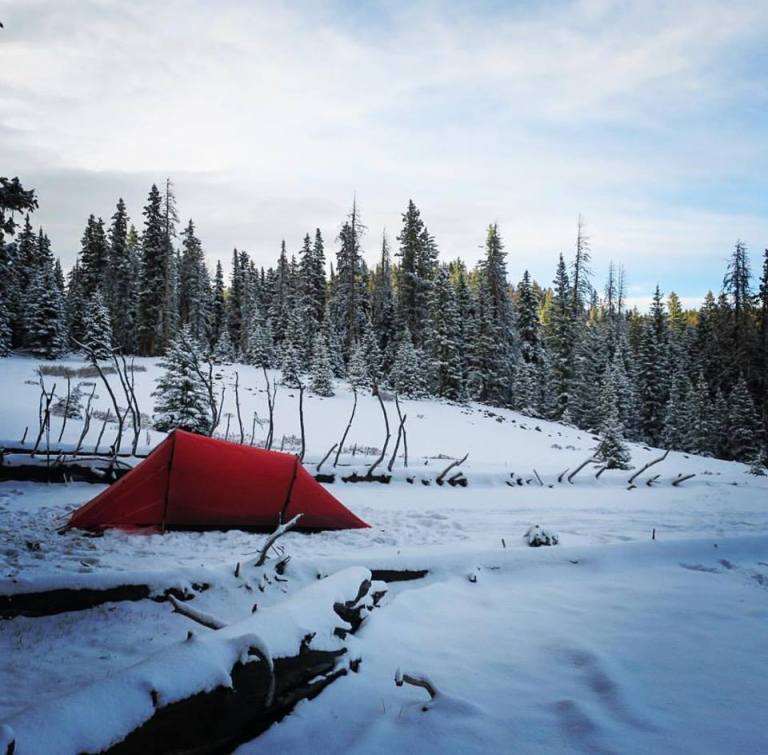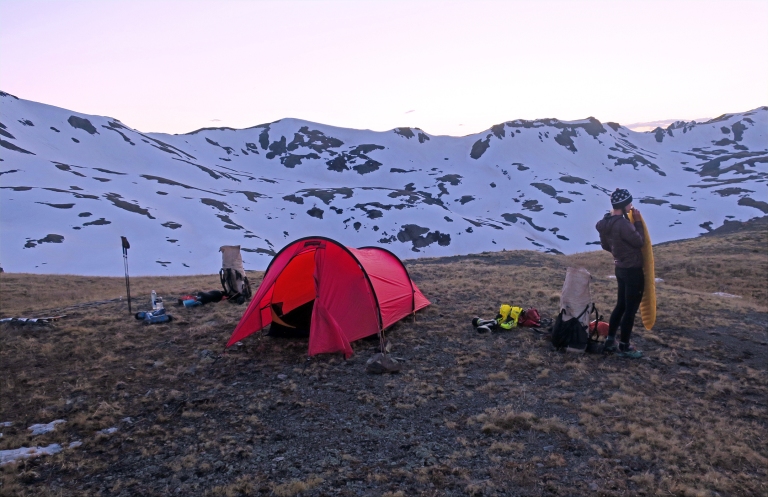
In the long distance thru-hiking world, taking a tent over a tarp is sometimes considered a luxury. But the Continental Divide Trail is a different beast from the Appalachian Trail or Pacific Crest Trail. It’s the highest elevation continuous trail in the United States and has more weather extremes, from harsh desert sand in New Mexico and the Great Divide Basin to weeks of sleeping above 12,000 feet in the Colorado Rocky Mountains. North bounders will almost certainly encounter crisp fall weather and snow in northern Montana. The insects in the Wind Rivers can be maddening. All these factors start to move the tent from a luxury item to something bordering on necessity.
Elaine and I initially started the trip with a pyramid style tarp. It worked quite well and was light. But the reality of a five month trip versus a week or even month long trip is that your shelter truly becomes your home. We craved more, something with a floor for muddy conditions, and a cozy feel of a home where we could really rest at night. It needed to be durable for the five month trip and a master of different terrain, including above-timberline alpine conditions. And of course, as is always the mantra in thru-hiking world, it needed to be light.

Hilleberg is not a popular brand among thru-hikers. Indeed the most popular models on the trail come from the brands Z-Packs and Big Agnes, well established in the thru hiking cult of gear. Some of this is weight based, but some comes from lineage. Hilleberg is a Swedish brand, well known in the polar exploration and mountaineering circles but much less so in thru-hiking world. Hillebergs are also known for being a bit more expensive than competitors – the Anjan 2 retails for $650.
Of course weight is also a factor. The Anjan 2, with stakes and poles, weighed 3 pounds, 2 ounces. It’s not the lightest tent on the trail, but between the two of us it was absolutely fine, basically 1.5 pounds each. When balancing lightweight with strength however, we were very pleased with the Anjan. There was never a time where we thought “Oh wow, this tent is too heavy and is really bogging us down.” That simply was not a factor. A solo traveller might consider the Hilleberg Enan which weighs right around two pounds.
We spent approximately 120 nights in the Anjan 2, putting it through the paces in wind, snow, rain, sun and everything in between. While not a free-standing tent, we found this was not an issue. It’s very easy to set-up. Basically, slide the two color coded poles through their respective sleeves, stake out one end, “snap” the tent to make it taught and stake out the other end. There are four guyline in addition to the end stakes, which we used every night in case of bad wind.

Speaking of wind – this is where the Anjan and Hillebergs in general shine. The were many nights on the divide where the wind was between 20-50 mph but the Anjan almost seemed oblivious to it. It’s ideal to face the front or back into the wind, but even if this is not possible the guy lines make it so the tent can handle a cross breeze with aplomb. Tunnel style tents like the Hilleberg do well in the wind. There was one night in particular just south of Rogers Pass in Montana. A cold front was moving thru and we had to camp in the open because all the trees were dead from beetle kill. The wind was howling. While it wasn’t the most restful night, the tent held strong and fast.
Rain was pretty much a non-issue with the Anjan. We stayed dry and we had no problems with splash-back under the tarp. The bathtub floor is strong and waterproof. We did not use a ground cloth, in large part because with Hillebergs you don’t really need one. We did encounter a fair bit of snow, especially later in the trip in northern Montana. It was the heavy, wet variety. This is the one area where tunnel tents, especially those made of the lighter fabric, struggle a little bit. Snow sags the fabric between the two poles, although we had much better luck handling this when we made sure the guylines were absolutely taught. It’s worth noting that the Anjan is billed as a three-season tent. Eight inches of heavy, wet snow is not what the tent is designed for, but it held up despite a bit of sagging.

Therein lies much of the beauty of the Anjan. It allows the backpacker to head out in weather that would prevent movement with some not-as-strong shelters. That’s a main reason to adventure – to get out in all conditions and see what nature is like at her most temperamental. Good gear with proper knowledge about how to use it allows one to enjoy the full gauntlet of conditions. For us, that was worth a weight sacrifice of a few ounces.

The inside of the Anjan is very comfortable and roomy. There was plenty of area for my wife and I with gear, including about 10 inches of space on each side to store random items. There is also a nice pocket on each side to stash your headlamp and phone at night. There is a clothes hanging cord off the roof, perfect for getting wet socks out of the way. Finally there was more than ample space to put our wet shoes at the bottom of the tent, a necessity to keep them from freezing solid overnight.

The vestibule is absolutely huge. We cooked in it 80 percent of the nights on the trail, exceptions being very nice weather and in grizzly bear country. Generally one of us would cook and the other would hang out at the bottom of the tent writing, sending satellite messages to family and friends and relaxing. The tent tapers significantly at the bottom, but it was still plenty roomy enough for relaxing with two people.
We traded out the under-gunned stock pegs for mini-Groundhogs from MSR. Lightweight is important, but breaking stakes on the trail is no fun and causes unnecessary stress. I would recommend this upgrade for any backpacker, regardless of tent choice.

One area that takes a little figuring out with the Anjan and the interconnected fly and tent body is what to do if the tent gets wet. If the tarp is soaked from rain, dew or condensation, it’s a little frustrating to stuff the whole thing together, soaking the entire tent. We ended up paying a lot of attention to the weather and getting very proficient at separating the inner and outer tent. If a warm, dry day was forecast, we’d put the tent away wet and then dry it out during lunch. If cold and wet weather was predicted we would take apart the inner and outer tent, keeping the relatively dry body separate from the soaked fly. Using these two techniques, we never really slept in truly soaking wet tent.
That said, the Hilleberg set-up method, which is so useful and quick in heinous conditions, does require a little more thinking when dealing with multiple days of rain in a row. Of course, we’re thru-hikers, up and hiking well before things can dry. For traditional backpacking, where breakfast is cooked and the sun is allowed to warm and dry things before setting out, this would not be an issue at all.

Being a bit of a warmer tent, the Anjan does suffer from some condensation. However, it’s not worse than any other shelter. When we camped with other hikers, we noticed that we got condensation when they got condensation and visa-versa. Condensation is a product of many things – campsite location, localized weather conditions and temperature difference between the inside of the tent and the outdoors. The Hilleberg breathes fine, has a large mesh door, a mesh window, and plenty of flow space beneath the tarp walls.
After three months of desert and mountain camping, we did have some problems with the front zipper. However, clamping them down with a small pliers on our multi-tool and squeezing them together about a millimeter fixed the issue in seconds. At the very end of the trip we got a tear in the fly on a seam near the front zipper. I’m not sure how it happened, but I suspect it was a result of overtightening the guy lines on the snowy night in the Bob Marshall Wilderness. True to Hillebergs though, the tear did not increase. When we got home we called Hilleberg and they gave us simple instructions for sending it in for repair.

That’s one of the best things about Hilleberg. They are a family operated company who are passionate about one thing: tents. Petra Hilleberg, who runs Hilleberg North America, is the daughter of founder Bo Hilleberg. She is a fantastic outdoors woman and has a real knowledge of the perfect shelter for everything from a hike along the CDT to a ski across Greenland. They also have an in-house warranty and repair department, following the mantra of re-use and fix.
Bottom line: Hillebergs cost a bit more money, but when looking for a bombproof two-person tent for three season backpacking in the high and low country, it would be hard to do better than the Hilleberg Anjan 2.


Great review – Hilleberg owes you 😁. Great pictures too!!
LikeLiked by 1 person
I have an old Keron 3, onenof their 4S tunnel tents, which I absolutely love! I’ve sent it in for repairs after 15 years of use and updated the poles.
LikeLike
Very good review, thanks so much. Was on the fence for months. My GF is new to camping so I need for things to go right every time. That said, the Enan seems too small for this 6’2″ guy. The Janan2 appears to fit the bill. Always been a believer in ‘You Usually Get What You Pay For.’ That’s all.
LikeLike